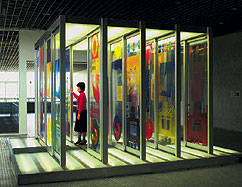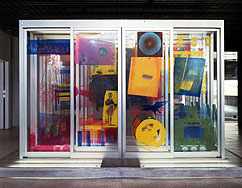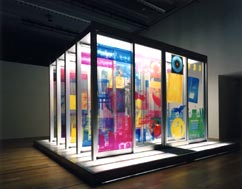 |
|
 |
| Photo courtesy: The National Museum of Art, Osaka |
 |
| Photo: TAKAYAMA Kozo |
|
|
Solstice was created as a new work for "Documenta II" (held in Kassel, former West Germany), and like Soundings, produced shortly before it, was a collaboration with engineers. It consists of five pairs of opening and closing automatic sliding doors, which are lit from the ceiling above and the floor below. The doors are covered with silk-screened acrylic panels. When the viewer passes through the doors he or she is surrounded by an array of images in different combinations. The opening and closing panels make possible a number of perspectives, which change at every instant as the viewers look at the images, walk, and then stop. The lighting from above and below makes the interior space seem like a "room of light" cut off from the outside world, an ambiguous world of light and colorful images. Some images are repeated in the same position (but in different colors) on each door and other images are screened in a more random manner. So one preceives both repeated and changing images as one passes through the doors.
While the images in Revolver appear in layers from the front, in Solstice they are continuously superimposed on the viewer's retina as he or she walks by. In Soundings, for instance, Rauschenberg did not employ the method he used in Revolver where individual viewers were asked to rotate the discs on their own. Instead, he used sensors to detect sounds made by viewers standing in front of the unlit mirrored panels. When a sound is detected, lights are activated which illuminate the acrylic panels placed in parallel rows behind the mirrors. At that moment the images in the work (a series of chairs viewed from different angles) appear superimposed on the reflection of the viewer in the mirrors. In this way the random interactive performances of the viewers directly contributes to the overall image of the work. In Solstice, however, Rauschenberg says that he was not asking that the viewers perform (which sometimes confused them), but rather, his aim was to show them the way in which images appear. But despite this difference in emphasis on the intentional actions of the viewer, in Solstice the work also comes into view as it incorporates the movements of the viewer's body, that is to say, the form of the viewer as he enters into the work. If the viewer comes back to the work a second time the overall image of the work is even more enhanced. When more than one viewer enters the work the image is influenced by the participation of each person, from his or her respective position. This kind of randomness makes the viewer's own movements appear reminiscent of the effect of the spherical mirrors that covered the interior of the Pepsi Pavilion, making it a fantastic spectacle of illusion and reality. The designers of the Pepsi Pavilion were looking to create a total environment that would emerge with the simultaneous input of mirror images of all of the viewers. Rauschenberg's concept of the "invisible environment" bore with it the possibility of an open space of mutual action and reaction that would transcend the limitations of the operations of a single individual. [KAMIKANDA Kei]
|
